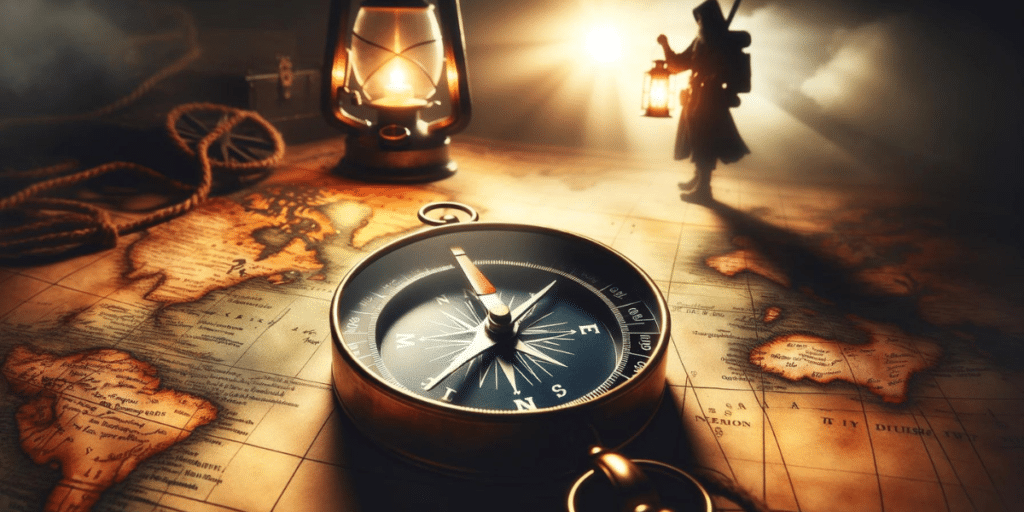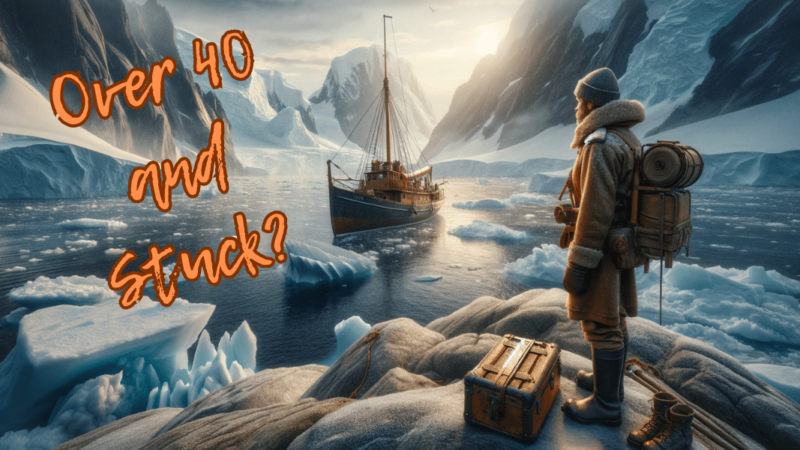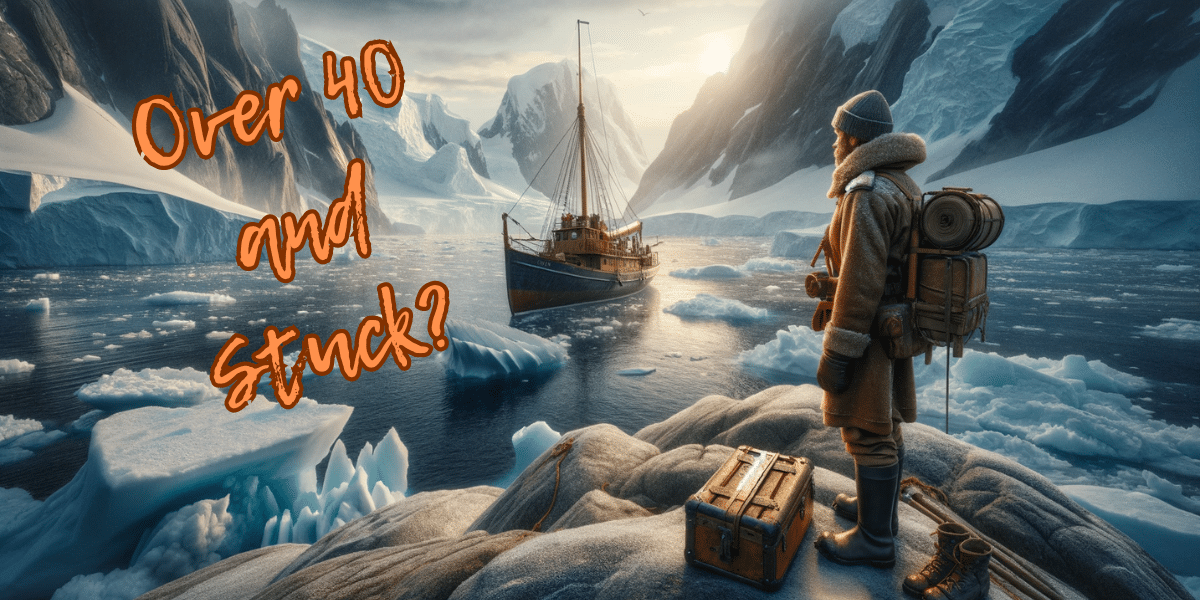Over 40 and Stuck? Inspiration to Break Free and Reinvent Your Life, The Shackleton Way!
Feeling over 40 and stuck? The story of Ernest Shackleton’s Antarctic expedition provides powerful inspiration that it’s never too late to face challenges head-on and reinvent your path. This blog post explores Shackleton’s extraordinary journey, drawing lessons on resilience, leadership, and transformation that can inspire you to make a significant change post-40. Let’s discover how to navigate the icy waters of midlife and steer toward a more fulfilling future.
Fortitudine Vincimus – Through Endurance We Conquer
April 15, 1916, on a small pebble beach on Elephant Island, at the northeastern edge of a chain of islands in the remote Southern Ocean, stood 28 men. For the first time in 497 days, they stood on solid ground. This inhospitable outpost gave the men of Ernest Shackleton’s Imperial Trans-Antarctic Expedition a tenuous grip on life.
Located 600 miles from the tip of South America, 550 miles from Port Stanley, and 800 miles from the island of South Georgia, they were virtually cut off from the world. Unknown to anyone and believed to be over 1,000 miles away at Vahsel Bay, their situation was dire.
The prospect of rescue was bleak.
Beaten and despondent, the men were resigned to a grim fate, facing the onslaught of a bitter winter with hurricane-force winds and freezing temperatures. Ill-equipped and suffering from severe frostbite, exhaustion, and the mental toll of their ordeal, they knew survival chances were slim.
The expedition’s leader, Ernest Shackleton, recognized that many were beyond self-rescue and that external help was a forlorn hope.
Shackleton realized what he must do.
Despite the overwhelming odds, he embarked on a perilous journey across the Southern Ocean in a modest lifeboat, aiming to reach South Georgia 800 miles away.
With only a small crew of the fittest men, the mission was clear: secure rescue for the entire party. The likelihood of success was minimal, but failure was not an option.
The lives of his men hung in the balance.
A Hopeful Departure
15 months earlier, the narrative had started on a vastly different note. On December 5, 1914, full of hope and thirst for adventure, the crew departed from South Georgia aboard the Endurance, aspiring to be the first to cross Antarctica.
However, the expedition quickly faced adversity, becoming trapped in the ice pack just a month into their journey. The Endurance was ensnared for ten months before it succumbed to the ice and sank.
The men then established a camp on the ice floe, enduring failed attempts to march across the ice to land, eventually hoping to drift north to safety on an ice floe.
The Drift to Desolation: From Ice Floe to Elephant Island
Embed from Getty ImagesAfter the Endurance sank, the men were adrift on a vast, open ice floe, a floating island in a sea of white. Shackleton recognized that to await rescue in their current location would invite death.
Their only hope lay in reaching civilization or a place where civilization might reach them. The crew’s situation grew increasingly perilous, with the ice pack constantly shifting and breaking apart.
Embed from Getty ImagesIn a desperate bid for survival, Shackleton ordered the construction of makeshift camps using the lifeboats and whatever materials were available from the remains of the Endurance. As the Antarctic summer waned, the ice began to melt beneath them, forcing the crew to confront the reality of their dire circumstances.
Shackleton decided to abandon the ice floe and seek refuge on Elephant Island. This decision would set the stage for one of history’s most incredible survival stories.
Embed from Getty ImagesUsing the lifeboats salvaged from the Endurance, the crew navigated through treacherous ice floes, battling freezing temperatures and navigating without the aid of landmarks. Their journey was dangerous, as they faced towering icebergs, fierce storms, and the constant threat of capsizing in the frigid waters.
After days of grueling effort, battling exhaustion, and the elements, the sight of Elephant Island emerged from the horizon—a stark, barren landscape, but to the men, a haven compared to the drifting ice.
Landing on Elephant Island was a monumental achievement, yet it offered little in the way of salvation. The island was uninhabited, far from any shipping lanes, and offered no hope for rescue. It was a temporary reprieve, a place to regroup and plan the next, even more daring phase of their quest for survival.
Shackleton knew that the only chance for rescue lay in reaching South Georgia. Shackleton decided to embark on a perilous journey across the Southern Ocean. This decision would require every ounce of their collective courage, skill, and determination.
The Perilous Journey Begins
In an audacious bid for survival, Shackleton and a select crew of five embarked on the journey across the Southern Ocean in the James Caird, a 22.5-foot lifeboat. Despite the daunting odds, they navigated through monstrous waves and freezing temperatures, demonstrating unparalleled navigation skills and an unbreakable will to survive.
After a harrowing 16-day voyage, they reached the rugged shores of South Georgia on the brink of death. However, their journey was far from over. They landed on the uninhabited side of the island, and the whaling stations—their hope for rescue—lay on the opposite side.
Across South Georgia’s Glaciers
Faced with towering glaciers and treacherous terrain, Shackleton and two of his crew undertook a grueling 36-hour march across the island’s uncharted glaciers and mountains. Without proper climbing gear, each step was a testament to their determination and resilience.
This final leg of their journey was fraught with danger, but their unyielding spirit propelled them forward. Upon reaching the whaling station at Stromness, they finally secured help. It was a moment of immense relief and triumph against the odds.
A Triumph of the Human Spirit
Embed from Getty ImagesThe rescue of the remaining crew members on Elephant Island was not immediate, as several attempts were thwarted by ice. However, Shackleton’s persistence never waned. On August 30, 1916, nearly four months after the James Caird set off, the Yelcho, a Chilean steamer, broke through the ice, reaching the stranded men.
No life was lost—a testament to Shackleton’s leadership and the indomitable spirit of all involved. This epic tale of survival against all odds is a powerful reminder of human resilience, the importance of hope, and the strength found in unity and shared purpose.
Why Adaptability Matters for Those Over 40 and Stuck

Shackleton’s journey was as much about adaptability as it was about endurance. When plans fell apart, he pivoted, setting new goals that focused on survival and rescue. He could easily have dwelled on the failure of his original mission and the lost prestige. But the survival of his men depended on his leadership. He had to adapt.
This flexibility is a vital lesson for personal development, especially in mid-life. How often do we all let both small and large setbacks impact us? It’s easy to look back on our lives at the miss-steps and missed opportunities, wonder what went wrong, and let these feelings guide our futures.
Shackleton made plenty of mistakes both in the preparation and execution of the expedition. No doubt, at times, the consequences of his decisions weighed heavy on him. But Shackelton had the ability to let go of what had gone, using a laser focus to make decisions based on his present circumstances. Can we say the same when faced with what are often far less challenging circumstances in our daily lives?
The ability to let go of what has gone and focus only on the reality of our current situation is a fundamental skill for growth and development. It reminds us to remain adaptable, ready to reassess our paths and redefine our objectives in response to life’s inevitable changes.
Lessons in Leadership, Resilience, and Determination To Transform Midlife

Shackleton’s ordeal on the ice and his subsequent rescue mission offer profound lessons in resilience, leadership, and the power of unwavering determination—qualities that resonate deeply, especially for those on the wrong side of 40 who may feel stuck in life and are looking for a way forward.
1). Embracing the Challenge

Just as Shackleton faced the Antarctic’s merciless expanse, life after 40 presents its own icebergs and frozen seas. The key lesson here is the importance of confronting our challenges head-on. Rather than succumb to despair, we must find strength in adversity, recognizing that every obstacle is an opportunity for growth and self-discovery.
2.) Leadership and Vision

Shackleton’s ability to maintain morale and foster a sense of shared purpose among his men, even in the bleakest moments, defined his leadership. This teaches us the value of vision and optimism in our lives. Whether leading a team or a family or steering the course of our personal journey, the ability to inspire, motivate, and see beyond the immediate hardships is crucial for achieving our goals.
3). The Power of Decision

Faced with seemingly insurmountable odds, Shackleton made the audacious decision to navigate the treacherous waters of the Southern Ocean. His resolve underscores the transformative power of decision-making. Taking bold, decisive action is sometimes necessary to move from where we are to where we aspire to be. It’s about turning our “should” into “must,” driven by the imperative to act.
4). Unyielding Perseverance

Finally, Shackleton’s story is a testament to the power of perseverance. Against all odds, he never lost sight of his responsibility to his crew, persisting until he secured their rescue. This level of perseverance is inspiring for anyone at a crossroads or facing uncertainty. It teaches us that we can navigate the stormiest seas and achieve our objectives with determination and faith in our capabilities.
Navigating Your Southern Ocean
Ernest Shackleton’s Antarctic adventure, fraught with peril and imbued with lessons of resilience, inspires anyone seeking to transform their life after 40. It teaches us that with courage, leadership, decisive action, adaptability, and perseverance, we can face the frozen seas of our own lives and emerge victorious.
Sources:
“An Unsung Hero – Tom Crean – Antarctic Survivor” – Michael Smith.
“Endurance” – Alfred Lansing.


